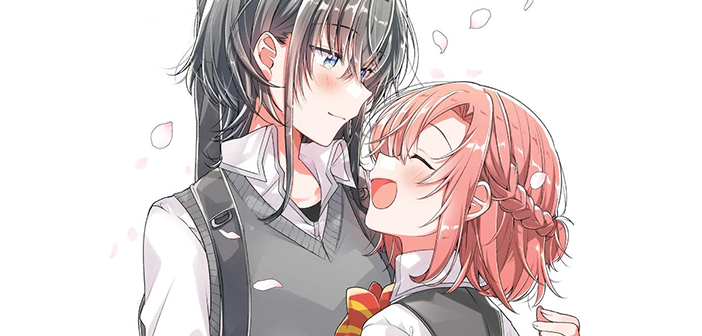
Eku Takeshima’s Whisper Me a Love Song gets off to a great start in its first volume, laying the groundwork for a super-cute yuri romantic comedy about the comical misunderstandings and awkward moments that the word “love” can bring.
Is there any word in the world more complicated than “love”? It can mean so many different things in so many different contexts. It can be liberating, or it can come loaded with baggage. It can be the happiest word in the world to hear, or it can be heartbreaking. No wonder it can be so difficult to pop the “L word” for the first time.
But apparently not for Himari Kino. She begins her first day of high school by instantly falling in love with Yori Asanagi, the singer in a band performing at the school’s opening ceremony. In a chance meeting with Yori in the hallway later that day, Himari can’t help but blurt those words: “I fell in love at first sight!”
Needless to say, it’s a surprising, shocking revelation for anyone to hear from someone they’ve never met—and certainly for Yori, the shy and reserved individual that she is. But Himari had actually caught Yori’s eye during the performance, too, and she’s not exactly displeased by the confession. In fact, she starts to think that she also found love at first sight, and manages to find the courage to say so…
But again, “love” can mean a lot of different things in a lot of different contexts. What soon becomes apparent—at least to Yori, if not to Himari—is that they mean very different things by that one small but endlessly complicated little word.

This sets up Whisper Me a Love Song for cute, funny, sometimes bittersweet romantic comedy. It’s a story of two young women who are each, in their own way, head over heels for one another, trying to navigate this budding friendship and maybe (hopefully) more. Volume 1 largely exists to lay the foundations and introduce the main characters, but that doesn’t stop it from having plenty of highs and lows. It works hard to give readers an emotional connection with the Himari and Yori and deliver on that, while also setting the scene for more to come.
The dichotomy between the two leads is where Whisper Me a Love Song‘s strengths come through brightest. Himari is bold and energetic to a fault, with no apparent filter—she says whatever comes to mind, with no care whatsoever about being perceived as “coming on strong”. She’s a little naive and a bit goofy, and when she sees and hears Yori for the first time, her entire world becomes about trying to spend as much time with Yori as possible, and to listen to her sing at every opportunity.
Yori is the opposite: painfully shy and reserved, and struggles to convey any sort of emotion. Before she met Himari, she didn’t even think love was really a thing—and certainly not a thing for her. Despite the way they met, Yori actually hates performing; she did is a favour for her friends, and usually saves her singing for when she’s alone. (But maybe singing for Himari, when they’re alone together, could be quite nice…)

This juxtaposition paves they way for plenty of laughs in humorous misunderstandings and cute, awkward little moments, but it’s also what makes the developing relationship between Himari and Yori so adorable and just a tinge bittersweet. To see Yori making her confession, knowing what sort of person she is, is beyond delightful (don’t worry, that’s not a spoiler—it happens in the first chapter, and is very much the inciting incident for the story that follows). Seeing her come to realise that maybe Himari doesn’t mean the same thing when she says “love” is a littleheartbreaking, but it’s hard not to want these crazy kids to get together all the same.
Even just in this first volume, Whisper Me a Love Song carries that dynamic to all sorts of funny, romantic ends, while also laying the seeds for even more romance and drama to come. Coupled with suitably cute character designs and a gorgeous art style, it’s a great start to what’s shaping up to be funny, sweet romantic comedy series.

Whisper Me a Love Song, Vol. 1 is written and drawn by Eku Takeshima. It’s available now from Kodansha Comics.
A review copy was provided to Shindig by the publisher.

